U-M’s "Merry Wives of Windsor" brings Falstaffian wit to the holiday season
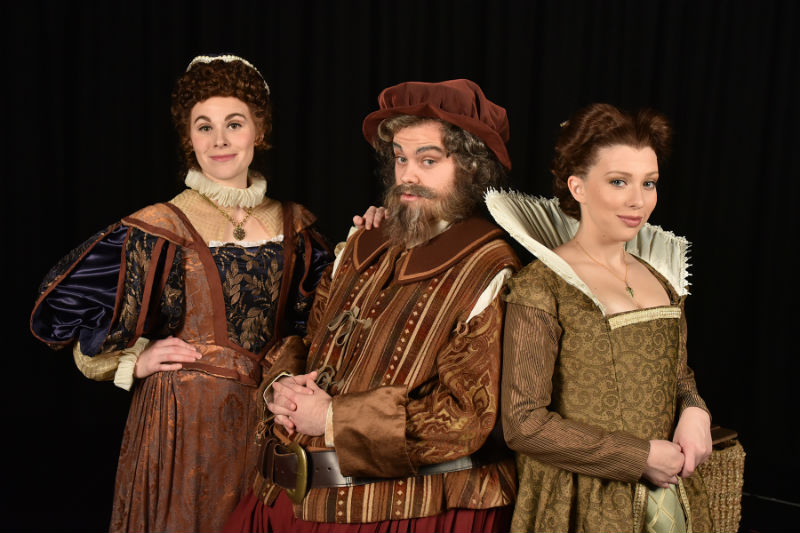
The story is that Queen Elizabeth I was so delighted by William Shakespeare’s raffish Sir John Falstaff in the historical plays Henry IV, Part 1 and 2, that she asked the playwright to give the rotund knight a play of his own, a love story for an aging rogue.
The Merry Wives of Windsor, Shakespeare’s only farce, has been a hit ever since. The University of Michigan’s Department of Theatre hopes to brighten the holiday season with its production of the play, Dec. 7-10 at the Power Center, under the direction of John Neville-Andrews, a professor of theatre at UM.
“I looked at the season and it’s a very serious and somewhat political season, so I thought around Christmas time we needed something humorous, funny, and enjoyable; hopefully a broad comedy for the public to come see at Power Center,” Neville-Andrews said.
Neville-Andrews said he has a particular fondness for this play.
“I’ve directed it a few times and I was lucky enough to have another crack at it,” he said, “I’ve come at it with a very different approach.”
Neville-Andrews said he is making the comedy broader than in his previous productions.
“I must confess there are some anachronisms that I have put in,” he said. “I’ve indulged myself a little bit. I’m hoping that will enhance the comedy and people will respond to that and not say, 'Well, you’re not doing Shakespeare, people weren’t like that in the 16th century.' So, I’m not doing Shakespeare in the most traditional way.”
Merry Wives of Windsor is far from the serious intentions of the Henry plays, which concern the maturing of young Prince Hal on his way to becoming Henry V. Here the action moves from London to the smaller community of Windsor, in the shadows of Windsor Castle. Falstaff and his pals from London move their antics to the Garter Inn in Windsor. Falstaff sends identical love letters to two married women, Mistress Ford and Mistress Page. When the two women compare notes, they begin to hatch a plot of revenge against the amorous and calculating Falstaff.
“It’s the only comedy that’s set in a specific town. Other comedies -- As You Like It, Twelfth Night -- are set in faraway places. When you look at it, it’s really about community,” said Neville-Andrews.
The community has welcomed outsiders before: a French doctor, a Welsh parson, and Mistress Quickly with her cockney accent.
The portrayal of this community is enhanced by set designer Gary Becker’s three-dimensional recreation of Windsor.
“It looks like the town of Windsor. In fact through the arch upstage you can actually see Windsor Castle,” Neville-Andrews said,
The set includes six Elizabethan houses on stage. And it’s all set for farce with four doors, a couples windows and the arch.
Some critics have complained that this Falstaff is not the same as the Falstaff in the Henry plays, where the heavy drinking knight was a sodden mentor to the future king. Neville-Andrews agrees that he doesn’t resemble that Falstaff, “but to a certain degree he does.”
“He’s still that chubby, ruffian, ragamuffin Falstaff and he’s still after money as he always is in the Henry plays. He and his cronies sort of ambush people to get their money, so he often seems to be in need of money and he needs money in this play as well,” Neville-Andrews said.
Queen Elizabeth asked for a Falstaff in love play, but Neville-Andrews said he doesn’t think she got what she asked for, as Falstaff is more in love with money and himself then the women he pursues.
The slender, young U-M junior Liam Loomer dons some extra padding to play the lead role of the fat old man with the witty quips and outrageous behavior.
“It’s really interesting, isn’t it, having to inhabit a physical space I’m not usually inhabiting,” said Loomer. “I also play with age. Falstaff is a little farther up in age than I am personally.”
Loomer said he is trying to find a way to show redeeming qualities in the old knight.
“It is about his love for himself and his love for money,” Loomer said. “But I’m trying to find a way to show his other connections to humanity and I think it’s easier in the Henry plays because of his connection with Hal as a father figure and not as easy to see in Merry Widows.”
Loomer said he got some experience playing a middle-aged character in U-M’s production of Ah Wilderness.
“He wasn’t as old as Falstaff; it’s not easy," Loomer said. "We were talking last night and he’s still a little too youthful. I am in my youth, fortunately. One thing about Falstaff, he’s sort of youthful in spirit and has a certain innocence."
Falstaff gets his comeuppance from the merry wives of Windsor, Mistress Ford and Mistress Page, who out-trick the master trickster and others as well. Christie Moyle plays Mistress Ford and Mallory Abnet plays Mistress Page.
“I like to think that we are the smartest people in the room at all times. Which is pretty much true,” said Moyle. “They plan everything, they know what’s going to happen, they see it through. What I’ve found interesting is that it doesn’t come from a place of malice but they genuinely enjoy doing it.”
Moyle and Abnet agree that their antics grow as much from boredom and a lack of attention as from any serious attempt to do harm to Falstaff.
“This isn’t the first time they’ve done something like this and it’s funny,” said Abnet. “You have Falstaff trying to woo us and we have an opportunity to pull a prank and it’s so enjoyable.”
Moyle said the males can be easily tricked because they don’t take women seriously.
“We trick our husbands, we trick everybody,” said Moyle.
Abnet said it was interesting that the women were not one-note.
“There is a line that the wives may be merry but honest, too, and the men all assume they can only be one thing and with all these tricks they are constantly proving they are so much more than that stigma,” Abnet said.
The actresses had to adjust to the biases of the times and also the physical discomforts.
“The corsets are hard,” said Abnet. “I didn’t think they were going to be hard. When I went for my first costume fitting I was so excited, the corset felt great. But there is a lot of running around and carrying the basket (with Falstaff inside) and throwing things so I didn’t realize it would be so restricting, and I have so much respect for the people who actually wore those things.”
Though the play is intended to get an audience laughing, Neville-Andrews said the theme of community may leave audiences thinking about some current events.
“When Falstaff comes to Windsor, he’s an outsider and has to be accepted and he has to be ‘tortured’ and go through some kind of trial before they welcome him in,” Neville-Andrews said. “By the end of the play, they all come together accepting Falstaff and his cronies who are invited back to a dinner and a big fire. If you think of Falstaff and his cronies as being like immigrants to a country that doesn’t belong to them, it might be a stretch, but there is a lesson in there about how we accept or don’t accept immigrants into our country. Do we accept their religion, do we accept their manner?”
Hugh Gallagher has written theater and film reviews over a 40-year newspaper career and was most recently managing editor of the Observer & Eccentric Newspapers in suburban Detroit.
"The Merry Wives of Windsor" will be presented at 7:30 pm on Dec. 7, 8 pm on Dec. 8 and 9, and 2 pm on Dec. 10 at the Power Center on the central campus of the University of Michigan. For tickets call the League Ticket Office at 734-764-2538 or go online to tickets.smtd.umich.edu.
Mash-Up 'Mime: Theatre Nova's "The Year Without a Panto Clause"
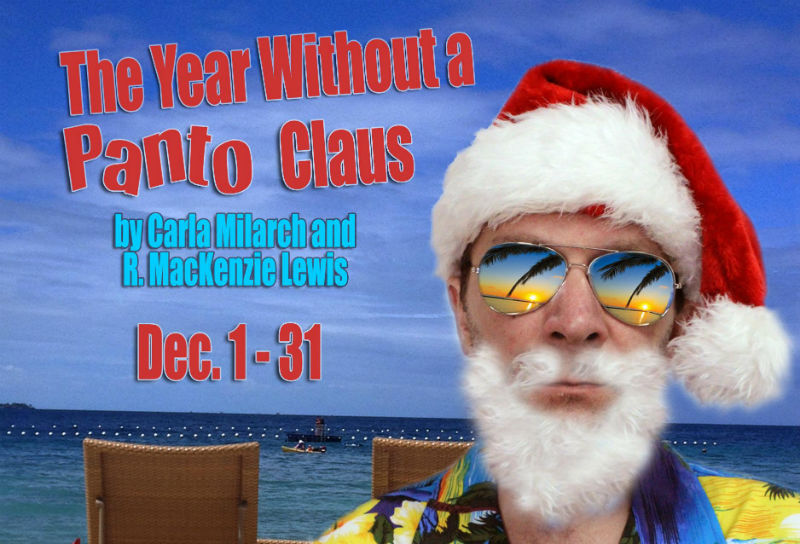
Around the holidays, theater troupes often feature classic Christmas plays familiar to Americans. But for the past two years, Ann Arbor’s Theatre Nova has presented an American twist on a British Christmas tradition. A panto, short for pantomime, is a variety show that developed in England in the 18th century that employs song, dance, comedy, and much more to tell a Christmas-related story.
This year’s panto, The Year Without a Panto Clause, is written by Theatre Nova artistic director Carla Milarch and features original songs by the show’s music director, R. MacKenzie Lewis, who has composed music for Nova's previous two pantos as well as for last year’s hit musical Irrational.
I spoke with Milarch about the inspiration for her pantos and what makes this show unique.
Q: For readers that may not be familiar with the panto tradition, would you explain what different activities make up these performances?
A: I always describe a panto as a mash-up of a musical comedy, stand-up comedy, a vaudeville act, and an old-fashioned melodrama, with a heaping helping of The Three Stooges thrown in. There's a good deal of falling down, chases, booing the villain, cheering the hero, political humor, and jokes -- and, of course, candy for the kids.
Q: Theatre Nova has put on a panto for their holiday show for the last two seasons. Whose idea was it to showcase an art form that is rarely seen in the U.S.?
A: It was Emilio Rodriguez's (of Black and Brown Theatre and now UMS). He had seen a panto in Los Angeles and suggested it.
Q: How do you get the ideas for each show, and specifically, how did you come up with the story of this year’s show?
A: A traditional panto is based on a children's story, usually a fairy tale. In Britain, they do Cinderella, Jack and the Beanstalk, and Dick Wittington and His Cat, among others. We wanted to put an American twist on ours, so we decided to narrow it down to Christmas stories that Americans would be familiar with. So far, we've done a twist on Rudolph (An Almost British Christmas), The Nutcracker (Sugar Plum Panto) and now The Year Without a Panto Clause.
Q: Can you talk a little about your collaboration process with R. MacKenzie Lewis? Does Lewis write some of the music for the shows?
A: Between our theater gigs and our kids, Lewis and I are some of the busiest people I know. So, we do a lot of work remotely. I come up with lyrics and ship them off to him; he tweaks them and writes the music and ships them to the actors. They learn them and I eventually hear them. It's unusual because I trust him so implicitly that I know whatever he does I will love. I literally have not heard some of the songs he's written for the show yet, but I know they will be fantastic!
Q: Do you both pick the popular songs that will be included in the narrative or does Lewis do it all himself?
A: I actually pick the popular songs as I'm writing the play because, usually, the inspiration for what's needed will hit me in the moment.
Q: During every performance of the show, there will be a different special guest performer who will be a small part of the variety act portion of the panto. Is this something unique to Nova’s pantos, or did this originate in England as well? Can you tell us some of the guests you’ve had in the past, and give us a preview of who we might expect this year?
A: This is all a part of the panto tradition. We have wonderful special guests this year. We're bringing back crowd favorites Gemini and magician Jeff Boyer as well as a lot of local theater folks you'll recognize from shows at NOVA and around town. I'm hearing rumors that Santa himself might make an appearance at some point in the run (the REAL Santa, not the one in the show!)
Q: What can audiences expect from this year’s panto, and what are you most excited for them to see?
A: The thing that I'm excited about the most this year, is that I think that this panto, in particular, holds up more as an actual play than the previous two. A panto is a very specific style, with lots of stuff in it that isn't your typical theater fare. In both past years I think we've been successful at creating a show that appeals to young kids, with lots of falling down, zaniness, etc. I've even had some Brits tell me it was "just like home!" This year, I think the play, although it maintains all of the zaniness, trust me, also has a thread of a touching and heartfelt story that is genuinely moving and carries you along in the more traditional theater vein.
Q: Is there anything else you’d like to say about this panto?
A: The premise of the play is that 2017 has been a bummer of a year, and Santa, like many of us, is starting to feel too depressed to carry on with life as usual. So, he decides to cancel Christmas. Jingle and Jangle the elves then set off on a hilarious journey to parts hither and yon to find some Christmas spirit to get Santa back in the saddle. Hilarity, zaniness, and musical comedy ensue. But I think at the core of the play is the genuine question we all feel of how we find hope in the world today. I think the play will give the audience some hope, but at the very least we'll give them a much-needed respite and a chance to laugh at our troubles, dance our cares away and focus in on the true spirit of the season. I'm happy with the way it turned out. I think audiences will be, too.
Emily Slomovits is an Ann Arbor freelance musician, theater artist, and writer. She plays music with her father and uncle (aka Gemini) and others, is a member of Spinning Dot Theatre, and has performed with The Encore Musical Theatre Company, Performance Network, and Wild Swan Theater.
“The Year Without a Panto Clause” runs Dec. 1-31 at Theatre Nova, 410 W. Huron St., Ann Arbor. For tickets and more information, visit theatrenova.org.
Thanksgiving Tradition: Matt Watroba at The Ark

Thanksgiving is all about traditions. And over the last couple of decades, one tradition that has taken root in Ann Arbor is Matt Watroba’s Day-After-Thanksgiving Concert at The Ark.
The well-known Michigan performer, songwriter, and radio host isn’t exactly sure how long he’s been doing the concert on the day after the holiday, but he estimates it’s been about 25 years. It’s become his most popular annual gig, and he knows some families incorporate it into their regular holiday plans.
“It has taken on a real community feel,” he says. “People are actually making it a tradition.”
While the annual show often features some guest performers, this year’s edition will likely be something closer to a solo show -- although he notes, “There’s always the possibility of surprise guests popping in.”
Watroba’s wife, Kim, will sing with him for part of the concert. “It’s awfully fun to sing love songs on stage with someone you actually love,” he says.
Since the audience typically includes some longtime fans, Watroba will try to include some material from all his past albums. And he’ll definitely include a “community sings” component, something that has become a major focus for him in recent years.
The community sings movement encourages regular gatherings of people to sing as a group, regardless of musical ability. Watroba’s involvement began when he conducted a radio interview with folk music icon Pete Seeger, the dean of the movement, aged 89 at the time. At the close of a long, accomplished career in music and social activism, Seeger told Watroba his most important work was getting people to sing for themselves.
“That just astounded me,” Watroba recalls. So, a couple years later, “Living in a country that seems to be more polarized than ever, I got the notion that it was time to take up Pete’s invitation.” He now leads some regular community sings across the region, and he also spends time spreading the word and teaching others how to lead them.
Community sings can include classic folk songs as well as newer songs that can be easily taught. The type of song doesn’t matter; the act of singing together is what’s important. “Everybody leaves feeling better than when they got there,” Watroba says.
Although he’s well known throughout the region as a performer -- both on his own and in partnership with Robert Jones, with whom he’s also creating a new nonprofit called Common Chords -- many fans first came to know Watroba via radio. For more than 20 years, he hosted the Folks Like Us show, primarily on WDET, playing a wide range of acoustic-based music.
Just last month, he returned to the Michigan airwaves: Folk With Matt Watroba now airs 6-8 p.m. Sundays on WKAR in East Lansing, and it can be streamed online at wkar.org.
“It’s really been heartwarming,” Watroba says of the reception to the show. “WKAR has just bent over backward to make it happen.”
He’s committed to always featuring some Michigan artists on the show, and he also includes a calendar of folk music events around the region -- both of which were important features of Folks Like Us. He notes with a chuckle, “That old show had an effect on a lot of people.”
Bob Needham is a freelance writer; the former arts & entertainment editor of The Ann Arbor News and AnnArbor.com.
Matt Watroba plays The Ark, 316 S. Main St., at 8 pm on Friday, Nov. 24. Tickets are $20/$27; a dinner-show combination is also available in conjunction with Conor O’Neill’s for $30/$37. Visit theark.org for tickets and more info.
Mini MoogFest 2017: Sound Science
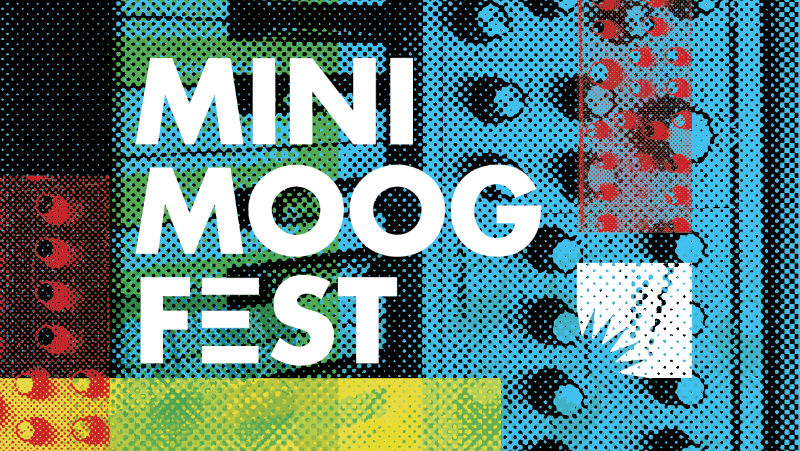
Robert Moog had no musical talent. But his talents changed music.
At the age of 15, Moog built his first Theremin, the ghostly, no-touch instrument created by Leon Theremin in the 1920s that used the amplitude and voltage of radio waves to manipulate two oscillators controlling pitch and volume. Moog continued to use his engineering skills to fine-tune these instruments, and by age 19 he was selling Theremin kits to help fund his college studies.
In 1964, the year before he earned his Ph.D. in engineering physics from Cornell University, Moog created his first synthesizer. By 1968, everyone from Stevie Wonder to The Beatles had used Moog synths on recordings, and in 1969 Wendy Carlos -- a frequent advisor to Moog -- had a chart-topping hit with Switched-On Bach, an LP featuring all-electronic versions of classical masterpieces.
By the early 1970s, the Minimoog Model D -- the world's first portable synthesizer -- became a staple in popular music and set the groundwork for all electronic music that followed, from the ambient bliss of Brian Eno and film soundtracks of Vangelis to the robotic beats of Kraftwerk and the entire genre of Detroit techno.
It's with Moog in mind that we created the Ann Arbor District Library's Mini MoogFest (Sat. Nov. 18, 12-4 pm, downtown branch). But it's a really a celebration of all the things that whoosh, squiggle, chirp, beep, bleep, and gurgle, from Don Buchla's equally important modular-synth inventions in the 1960s right up to today's home-brew makers who bust out the soldering irons and circuit boards to create their own custom sound modules.
At Mini MoogFest you'll be able to test out a variety of effects pedals, music-making software, and electronic instruments, including Moog modular units and Thereminis, the Arp Odyssey, and many more. Many of the pieces are available to borrow from AADL's Music Tools collection, too. Think of it as a music store where you won't get yelled at for playing around with the gear.
We'll also have three performances in the multipurpose room by artists who will talk about how they create their sounds, from the basics of synthesis to the specific gear in their stage setups. The lineup is:
➥ 1 pm: Sean Curtis Patrick (➲ PULP INTERVIEW), Kendal Babl, and Chuck Sipperley
➥ 2 pm: Mike Dykehouse (➲ PULP INTERVIEW)
➥ 3 pm: North Coast Modular Collective (➲ PULP INTERVIEW)
Producer, audio engineer, and artist Alex Taam -- who records under the name Mogi Grumbles -- will also be on hand to allow folks to play with his various Moogs and modulars as well as assist people in exploring the gear that will be spread around in the Secret Lab. (➲ PULP INTERVIEW)
This is a family-friendly event, too, so bring the kids and let them make outer-space sounds, video-game soundtracks, and noise jams. There will also be giveaways featuring T-shirts, winter hats, patch cables, screwdrivers, buttons, and other swag from gear companies and dealers such as Make Noise, Line 6, Boss, Roland, Korg, Electro-Fautus, Control, Perfect Circuit Audio, Reverb, and Sweetwater.
If you've ever been interested in how to make electronic music, Mini MoogFest is the perfect opportunity to dabble, experiment, and invent. As with Robert Moog, no musical talent is necessary.
Christopher Porter is a library technician and the editor of Pulp.
Mini MoogFest is Saturday, Nov. 18, 12-4 pm in the multipurpose room and Secret Lab of the Ann Arbor District Library's downtown branch, 343 S. 5th Ave. Facebook event page. Check out interviews with Mini MoogFest performers Sean Curtis Patrick, Alex Taam, North Coast Modular Collective, and Mike Dykehouse.
Mini MoogFest 2017: North Coast Modular Collective
The North Coast Modular Collective is like a modular synthesizer: made up of many parts to create a sonic whole. The group is a loose collection of Washtenaw County-area musicians and creators who teamed up earlier this year and pooled their talents to share gear, create new instruments, and trade ideas.
The trio of Joe Bauer, Dan Blades, and Bill Van Loo will represent the collective at Mini MoogFest, and we asked them their about plans for the event, the gear they'll be using, and their favorite synth-leaning recordings. (Also, here's a primer on Eurorack synths, which the collective mentions several times.)
Q: What's your plan for MoogFest?
NCMC: Three of us from North Coast Modular Collective will be there. In short, we’re a group of artists, academics, and makers who aim to spread curiosity, enable exploration, and foster community. Then each of us will spend 15 minutes doing some combination of talking and performing.
Bauer: I’ll be playing about 10 minutes of semi-improvised electro-glitch music (similar to this or this) and then I’ll spend about five minutes explaining and demonstrating a few of the basic concepts and techniques I used. If you’re curious about how I get ready for a show you can follow me on Instagram or YouTube to see some behind the scenes clips as I get prepared.
Blades: I’ll spend a couple of minutes talking about my latest modular build. I’ll then be using it as an audio source and running the audio through some Eurorack effects. The set will be completely improvisational.
Van Loo: I will be performing a rolling 10-minute exploration of deep dub techno chords and sounds, and then spend about 5 minutes explaining what I used and how I used it. Check out the chromedecay Instagram account for behind-the-scenes takes on how this has been developing, via grainy 60-second square videos.
Q: What's your gear setup?
Van Loo: Since we’re focusing on the modular aspect for this performance, I’ll be using a single row Eurorack system, with a mix of prototype North Coast Modular Collective modules, modules from other manufacturers, and DIY pieces. Most of the main sounds will come from this single set of modules, but I’ll add some drum sounds -- some created with a virtual modular synthesizer called VCV Rack -- sequenced on the Novation Circuit. Delay and reverb will allow me to create the atmosphere I want for my set.
Bauer: I’ll be using a 9U, 104hp self-built Eurorack case with 32 modules from 18 different manufacturers. Fourteen modules were self-built. Of those, four are North Coast Modular Collective designs. English translation: I have a wood box with a bunch of electronics in it -- some of them I built, a few I helped design -- and wires and knobs hanging out of it.
This is what it looks like without any of the wires plugged in:
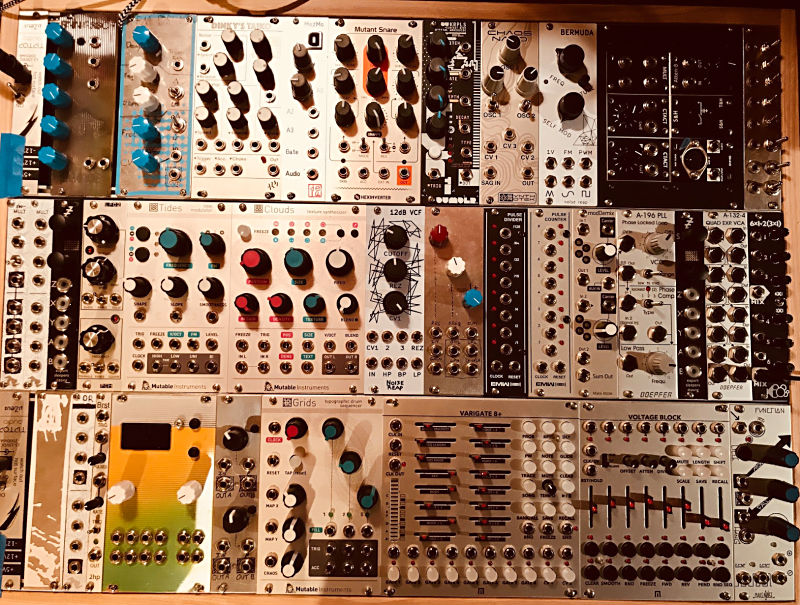
Blades: My main setup is mostly Eurorack. It’s my vessel to explore sound design. It’s constantly changing and evolving. Lately, I’ve favored modules that work well in live situations, modules that can sample audio, and modules that produce random voltages. I want my setup to surprise me and anyone who wants to listen.
This is my latest completed project that I will be using for my performance:
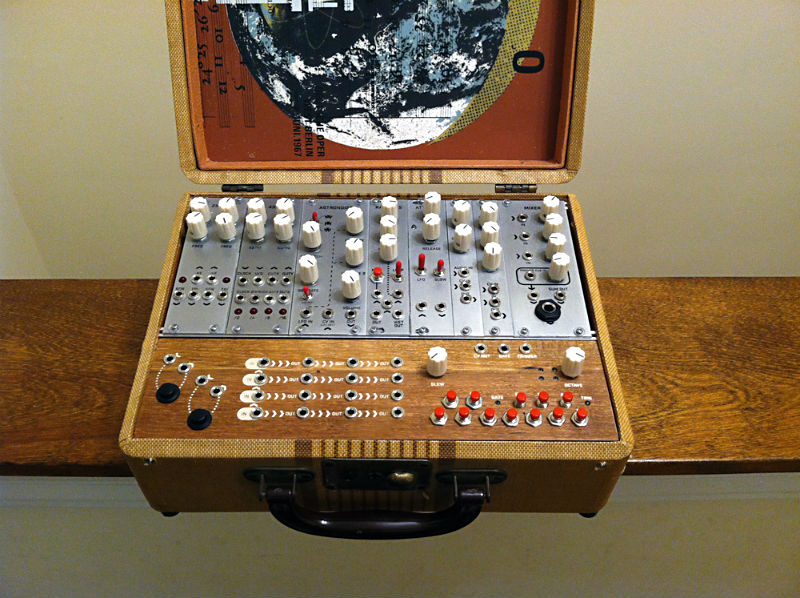
The idea behind this project was to build a flexible, self-contained, portable synth that had the capability of being used as a “traditional” monosynth but could also be an experimental sound platform. The synth is made up of 10 Eurorack modules, built from available manufactured PCB boards, installed into a repurposed vintage suitcase.
NCMC: North Coast Modular Collective tries to spread curiosity, enable exploration, and foster community. To that end, we held a three-day camp over summer where we designed and built our own set of modular synthesizer cases. During that time we also built and programmed a few modules from a popular module designer who goes by the name of mxmxmx.
Our design process often includes cardboard mockups of early concepts to make sure the design concept basics work in physical form. From there we commonly break up circuits into isolated building blocks and use several iterations of design/build/test for each design block before integrating them together into a single module.
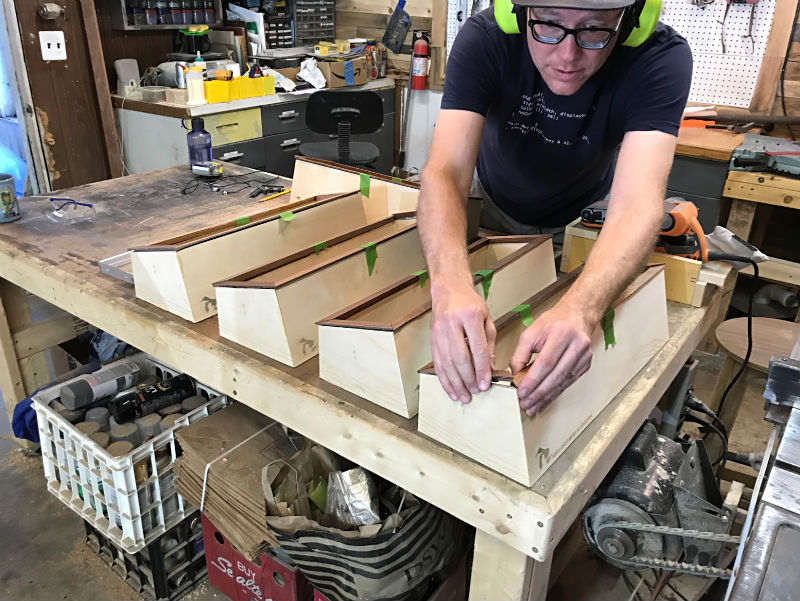
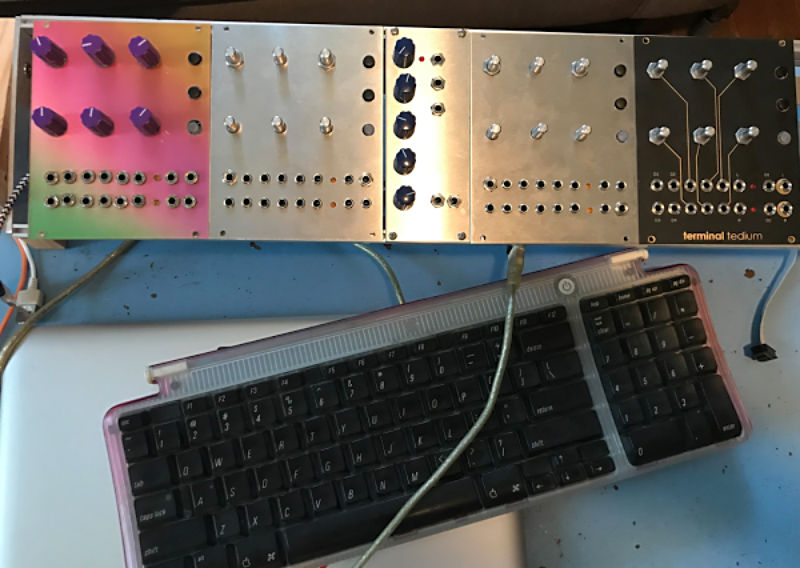
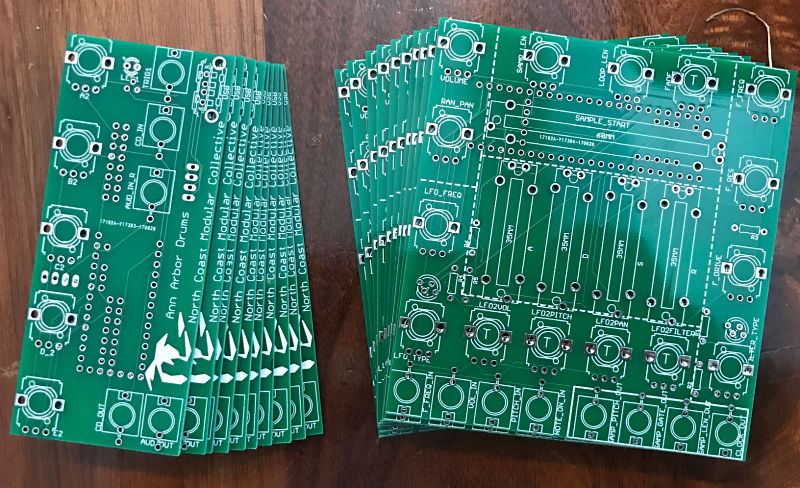
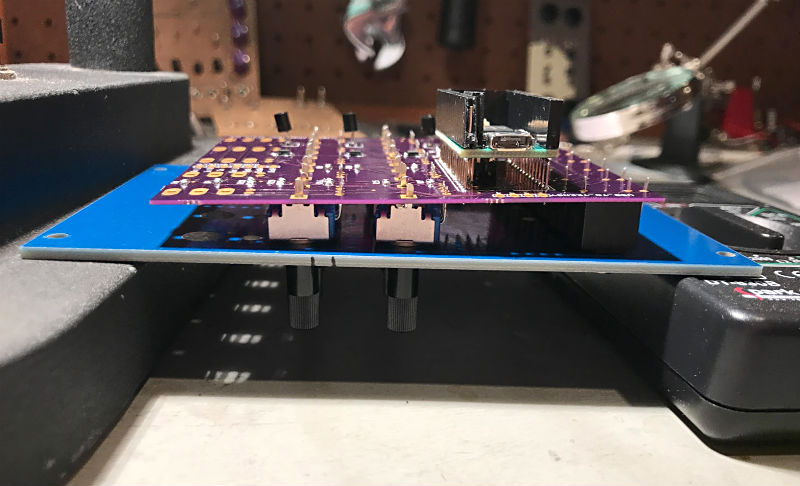
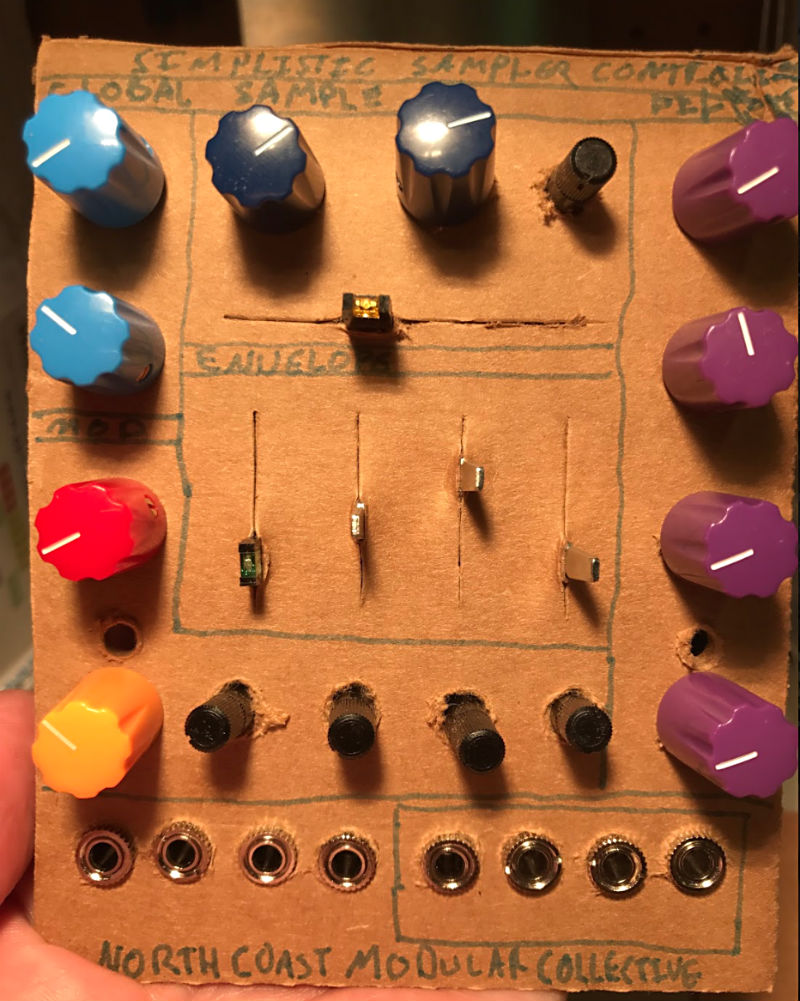
Q: Name some synth-related records that you'd recommend to newbies.
Bauer: It’s not a record, but I highly recommend watching:
➥ I Dream of Wires (AADL link). It’s a great introduction to the history of synthesis and does a nice job of putting some context around Bob Moog and Don Buchla and how their work still impacts music today.
Blades: One of my favorite artists:
➥ Venetian Snares, Traditional Synthesizer Music: A full album of live modular music created by Aaron Funk. Here is a video of Aaron with his modular performing a track from the album:
Van Loo: Here are a few records that have inspired me and are well worth digging into:
➥ Kraftwerk, Computer World: A perfect combination of pop sensibility with the most pure electronic sounds. Utterly classic.
➥ Monolake, Hong Kong: A deep slice of Berlin-based dub techno, using found sounds, synthesis, and echoes to set an amazing atmosphere. The duo went on to found Ableton, the company that makes Ableton Live, perhaps the most important piece of music software in the past 15 years.
➥ Telefon Tel Aviv, Fahrenheit Fair Enough: Impeccable sound design and programming. Still an inspiration 15 years after its release.
➥ Psyche/BFC, Elements 1989-90: Classic Detroit techno from one of my favorite Carl Craig aliases. “How the West Was Won” from this record may be one of the loveliest and most gently melancholic pieces of electronic music that exists.
➥ Steve Reich, Music for 18 Musicians: Not truly electronic at all, but so deeply influential to how I approach electronic music as to be essential, and Reich’s early tape and electronics work predates much of the current interest in things like Euclidean rhythm, field recording, and phasing.
Christopher Porter is a library technician and the editor of Pulp.
Mini MoogFest is Saturday, Nov. 18, 12-4 pm in the multipurpose room and Secret Lab of the Ann Arbor District Library's downtown branch, 343 S. 5th Ave. Facebook event page. Read our introduction to MoogFest here. Check out interviews with Mini MoogFest performers Mike Dykehouse, Sean Curtis Patrick, and Alex Taam.
Mini MoogFest 2017: Sean Curtis Patrick
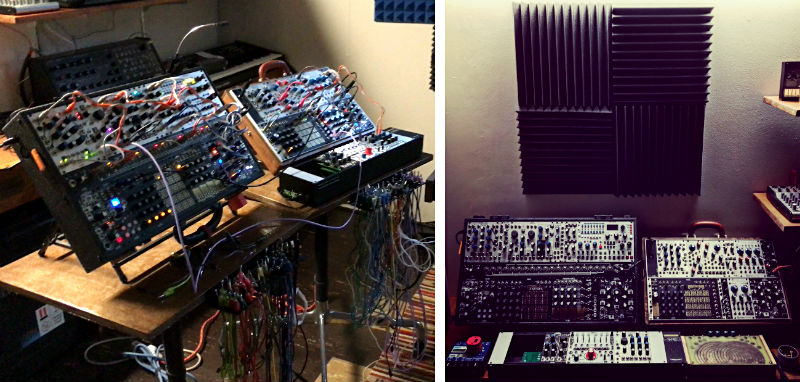
Sean Curtis Patrick is a visual artist who also makes music, so it's not unreasonable to expect when he and fellow visual artisan Kendall Babl team up with Chuck Sipperley -- expert DJ and super-synther in Hydropark and Utica -- the trio will paint electronic aural sculptures in your mind, MAAAAAAAAAN.
We asked Patrick what the group's plans are for the festival, the gear he'll be using, and received recommendations for his favorite synth-leaning recordings.
Q: What's your plan for MoogFest?
A: I’ll be playing with Kendall Babl and Chuck Sipperley, and I will be using my modular synth system.
I have two separate rolling tables, which will both be independent of one another. One will be more “playable” with a series of small pressure-sensitive pads to trigger a group of notes. The other system will be more textural.
A modular system is a really interesting way to create and modify sounds. To sum it up, it’s a series of building blocks, decided by the performer, that one can connect in different ways to create both simple and complex sounds using patch cables. It’s the closest thing to being able to make “sound science.” It looks scientific, that’s for sure. I would say that’s what the uninitiated say more than anything else: “Looks like a science experiment!” They aren’t wrong, it kind of is!
For this show, I’ll mainly be listening to what the other two will be doing to supplement their melodies with textures and the occasional measure of melody or some counterpoint. We are going to be fairly improvisational, too. I’m really excited to see what the other performers get up to and am thrilled to be able to attend and perform! Thanks for having us!
Q: What's your gear setup?
A: I am generally more known as a visual artist before a musician, and making visual art has allowed me to work with many wonderful musicians. I have made a lot of music videos and have done a fair share of art and design for albums. One particular person I have worked with for quite a long time now is my friend Alessandro Cortini. He is an incredible solo musician, lovely human being, fellow cat owner, and has been in the band Nine Inch Nails for the last decade or so. He asked me to work on a record of his that was going to come out on Make Noise Records, a component of Make Noise, a modular synth company.
I became pals with the Make Noise folks over the course of making that record and came to a great agreement with them that’s stands to this day: I make them art and I get paid in gear. I owe this new instrumental exploration totally to Kelly Kebel and Tony Rolando, and also to Make Noise pals Peter Speer and Walker Farrell. I can’t thank them enough -- 19 out of my 30 modules are Make Noise. I think they are the best modular synth company out there and I contend that Tony Rolando is my generation's Don Buchla, one of the pioneers of synthesis. I’d love to see how his brain works.
Anyway, my one larger black case is made my Make Noise and is called the Shared System, which is a full plug-and-play thing you can buy from them. The other case is a beautifully made black poplar case I commissioned from some guitar makers in Italy. It looks like the back of an acoustic guitar, with varnished bookmatched wood. They did a wonderful job and are total sweethearts. That case is filled with a number of manufacturers modules that complement the other system quite well.
I designed the tables that the synths sit on. The caster sets are Ray and Charles Eames-designed from the 1960s. I cut two plywood boards to size and installed cable management and power into the bottom. I wish I could go back in time to that kid (me) in a college dorm, programming computers to make rubbish-sounding drum machines and show them the setup he’d have one day. I feel very, very lucky to work with such lovely and talented people and the fact that I am able to use any of this still blows me away.
Q: Name some synth-related records that you'd recommend to newbies.
A: Some albums and some artists:
➥ Isso Tomita, Snowflakes Are Dancing: The record that hooked me on synths. I had to record this record on to a cassette at the university library. I still have it.
➥ Morton Subotnik, Silver Apples of the Moon: The record that allowed me to look at music through a different lens; music doesn’t have to be 3-minute jangly pop music. It can be serious, artful, and a bit challenging.
➥ Boards of Canada, anything: The best driving music ever-ever.
➥ Kaitlyn Aurelia Smith, anything: Wonderfully melodic chanty/Buchla Music Easel arpeggios. If people ever discounted electronic music having soul, play them her music.
➥ Burial, anything: A musician more than any other that has shown me you can make an amazing record with just a laptop and some dodgy Christina Agulera samples slowed down.
➥ Alessandro Cortini, Avanti: My pal Alessandro did it again. This record made me cry. I also did the art and tour visuals for it, all based on 8mm family films from his grandfather. My favorite album of the year, even if I hadn’t had anything to do with it.
➥ Supersilent, Supersilent 7: Improv jazz and synths? Tell me more. Play loud or, better yet, watch the accompanying concert DVD in a dark room. Max volume.
➥ Suzanne Ciani, Buchla Concerts 1975: One incredible mind, one amazing machine, two selected concerts recorded onto tape in New York lofts in 1975. If you were wondering what just one of these boxes could do, listen here.
➥ Various artists, Electronic Music Winners: Best known as the record that inspired Jonny Greenwood of Radiohead to write the track “Idioteque” but a lot of other amazing moments on this record.
Christopher Porter is a library technician and the editor of Pulp.
Mini MoogFest is Saturday, Nov. 18, 12-4 pm in the multipurpose room and Secret Lab of the Ann Arbor District Library's downtown branch, 343 S. 5th Ave. Facebook event page. Read our introduction to MoogFest here. Check out interviews with Mini MoogFest performers Mike Dykehouse, Alex Taam, and North Coast Modular Collective.
Mini MoogFest 2017: Alex Taam
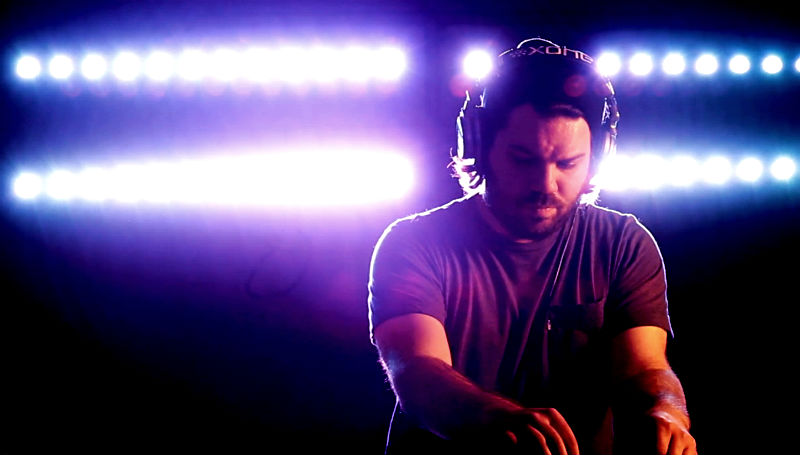
Alex Taam is a recording-studio engineer, composer, and all around gearhead. His mastery of synths is one of the reasons why we asked him to write and record two songs using instruments from AADL's Music Tools collection, which he did in February. Taam's knowledge about all things electronica is also the reason why we asked him to help us host Mini MoogFest. He'll be on hand to demonstrate some instruments, including a modular synth, and guide you through many of the other instruments we'll have on display for hands-on play.
We talked to Taam about his Mini MoogFest plans, the gear he's bringing, and asked him to name his favorite synth-related recordings.
Mini MoogFest 2017: Mike Dykehouse
In addition to being a remarkable painter, Mike Dykehouse is an immensely creative musician. But after his Dynamic Obsolescence (2001) album on the influential British electronica Planet Mu and another on Ghostly International with the shoegaze-y Midrange (2004), Dykehouse mostly went underground.
Or rather, to Instagram.
Dykehouse's daily video clips of new synth jams -- ranging from straight-up techno and boogie-bass electro to hip-hop boom-bap and exploratory noise -- are often highlights of his followers' days. (Am I projecting?)
In a rare live appearance, Dykehouse will demonstrate the latest version of his ever-changing modular synth setup at Mini MoogFest, giving listeners a front-row seat to his daily sonic rituals.
We talked to Dykehouse about his Mini MoogFest plans, the gear he's bringing, and asked him to name his favorite synth-related recordings. But to evoke the immortal Joe Perry Project, Dykehouse mostly lets the music do the talking.
U-M’s "Blood at the Root" challenges audiences to deal with race
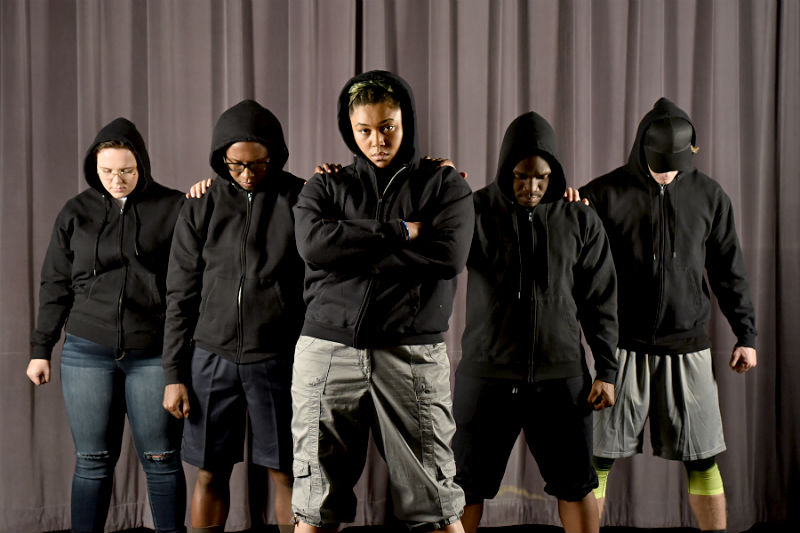
Southern trees bear strange fruit
Blood on the leaves and blood at the root
Black bodies swinging in the southern breeze
Strange fruit hanging from the poplar trees
--Abel Meeropol
In 2014 Stori Ayers was a graduate student in acting at Penn State University. She had the rare opportunity to be the first actress to play a key role in Dominique Morisseau’s Blood at the Root, which had been commissioned by the university. She and other cast members worked with the author to develop the play
After performances at Penn State, she continued to perform the role of Raylynn in a touring production across the United States and internationally.
Ayers, who now teaches at the University of Michigan School of Music, Theatre and Dance, will direct a U-M production of the provocative play, Nov. 16-20 at the Arthur Miller Theatre.
trustArt Gallery's "Studio Works" exhibit encourages community engagement
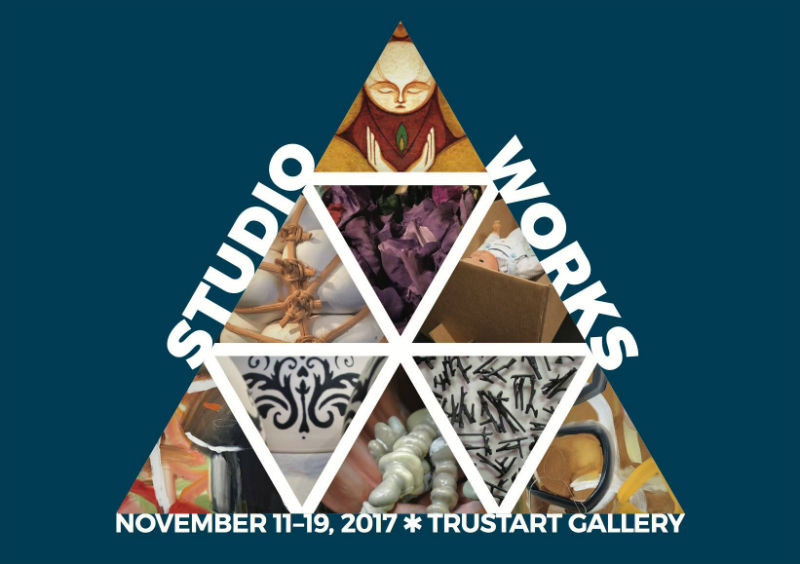
The trustArt Gallery's Studio Works exhibition (Nov. 11-19) will display multi-media works by artists and designers who work in rented studios at the venue. The exhibit features works by Larry Cressman, Liz Davis, Elizabeth Barick Fall, Rose E. Gomez, Barbara Hohmann, Allen Samuels, Laura Shope, and Lissie Williams, and it also offers an intimate look into the studio space and how it relates to the artists’ practices and everyday environments.
In addition to the more common gallery exhibition, the added opportunity to see the artists’ studios and working spaces aims to create community engagement with the arts, according to trustArt Gallery's statement: “We are connected through our location and environment as we pass through the shared open space of our gallery: it provides an opportunity to intersect; to cross paths; a place for our studio works to be shared and reflected upon; a chance to interact with each other and the community.”
The opening-up of studios to the community will allow for many people to interact with art and art making in an expanded capacity. It allows unique insight into aspects of the creative process and creates a chance for discussion and dialogue between the artist and the community.
Featured artists/designers:


































